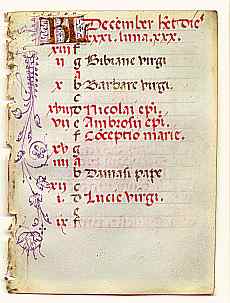



An early printing office.
If you are looking at this page without frames, there is more information about medieval writing to be found by going to the home page (framed) or the site map (no frames).
| Classical Revival | |||
| Scribes in Italy had never been so keen on the pointed, angular, compressed forms of Gothic script, just as Italians generally had never really become absorbed in pointed, angular and compressed Gothic architecture. What this shows about the national psyche I have no idea. In the early 15th century, another of those funny relationships between what you write and how you write it developed. Writers of the new humanistic mode of thought associated with what we have dubbed the Renaissance sought, in their writing style, to make what was old new again. (See Bischoff 1990, also Brown 1990, also De La Mare 1973) | |||
| A style of script which may or may not have been invented by Poggio Bracciolini (depending on who you believe), but he was very good at it, became known by association as humanistic script. The name, like many others, is not entirely logical. How can a script be humanistic? It was, in fact, a reinvention of Caroline minuscule, the script developed by grandiose Germanic barbarians long after the fall of the Roman Empire, but now associated with the graciousness of Classical culture and fine new modes of thought. | |||
| These maps show developments in the 15th and 16th centuries. | |||
 |
A sample of humanistic script from a 15th century translation from Latin into Spanish, and copied by an Italian scribe, of the Ethics of Aristotle (British Library, add. ms. 21120). (From New Palaeographical Society 1908) | ||
 |
As with other changes in script fashion, the change was not immediate and absolute. The new/old script hybridised with various other forms based on the early medieval minuscules, and also with the rotunda script of formal books to produce a family of forms. An elegant hybrid form combining humanistic script with the broad and rounded forms of rotunda is sometimes referred to as humanistic display script. | ||
| Humanistic display script in a calendar page from a northern Italian book of hours of the late 15th century, from a private collection. | |||
| Some Italian scribes of the period were also competent in diploma hands, and this resulted in the development of slanted versions which developed into humanistic cursive. | |||
 |
A somewhat untidy humanistic cursive in a 15th century Italian volume of the works of Cicero, by permission of the University of Tasmania Library. | ||
| A leaf from books of the Old Testament produced in Italy around 1470-80 is displayed by the Bodleian Library (MS Don.f.30, f.1r) showing humanistic script in a fancy decorative page. A detail of a neat humanistic hand in copy of Jerome, Lives of the Desert Fathers (X208/J48, f.177v) of 1436 from northern Italy is displayed by Columbia University Library. The Rome Reborn exhibtion from The Vatican Library shows a humanistic cursive in the Inventory of the Vatican Library of 1518 (Vat.lat.3955, f.1v-2r). | |||
| The humanistic script spread to Germany, France and England. The use of this reinvented minuscule went along with the revival of certain ancient scripts for headings; square capitals, rustic capitals and uncials. | |||
| The later 15th and 16th centuries saw the end of manuscript book production as printing techniques developed. In Italy, early printing presses employed the humanistic scripts as the basis for their typefaces. In France and England both Gothic textura and various varieties of bastarda scipt were employed in early printed books, but were gradually overtaken by the Italianate typefaces. In Germany, Black Letter Gothic was employed for typefaces well into the twentieth century. Eventually, the standard typefaces used over all of Europe were based on the humanistic scripts, which is why they seem so easy for us to read today. |  |
||
An early printing office. |
|||
| The manuscript production of legal and administrative documents long outlasted manuscript book production. In fact, they survived to the invention of the typewriter. In the late medieval period the scripts used for these documents diversified somewhat, with specialised scripts being produced by different agencies. Most were derived from or related to the bastarda or Secretary families. From this late period there survive writing masters' books which display the range of scripts that could be employed by a single scribe. Writing was developing its own historical sense. | |||
|
|
|||
|
|
|||
|
|
|||
|
If you are looking at this page without frames, there is more information about medieval writing to be found by going to the home page (framed) or the site map (no frames). |
|||